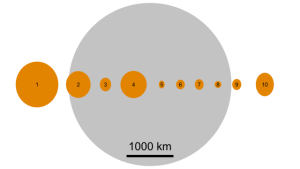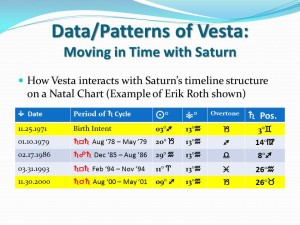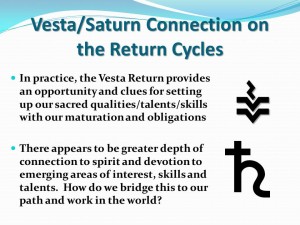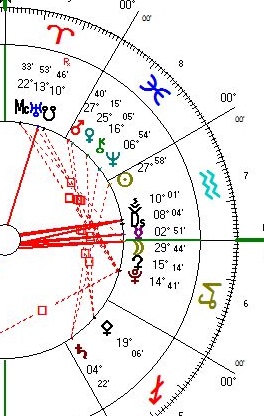in Shamanic Astrology
by Erik M Roth
How do they fit on an Astrology Chart?
How do the asteroids fit (or not fit) within the paradigm of Shamanic Astrology? Simply put, it is ever-evolving. When thinking about or using asteroids in astrology, one should look at what they bring to the table. A fundamental question is this: “Is there a role they play that is not seen in the Astrology Chart?” For 99.999+% of the asteroids (of the millions out there), the answer is truly “no”. But it is not really that simple.
Several years ago, I had an astrology reading done by someone who used thousands of asteroids to interpret my astrology chart. Was it effective? In my opinion, very little was effective. While the reading did cover some important and accurate points, it was confusing because much of that information can be already be derived from the planets, Sun and Moon as well as the Rising Sign. So, there was a very large overlap. However, the largest of the asteroids (specifically the “First 4”) do convey special details that can, at the minimum, flesh-out knowledge (already) gleamed (exception at this time being the asteroid Vesta) from the planets and signs with some directed focus.
Origins of Asteroids in Astrology, a Summary
When the first asteroids were “discovered” by astronomers Giuseppe Piazzi and Heinrich Olbers in the early 1800s, they were thought to be additional planets in the solar system and accorded official names (after Roman Goddesses) and symbols to honor those new planetary bodies. It was only several decades later when the instruments became more sensitive and precise, that the asteroids discovered at that time were in another class and nowhere near as big as the 7 (Neptune was discovered in 1846 and Pluto not until 1930) planets we knew about up to that point. Many dozens more were discovered beginning in 1845 and nearly every year since at least one more was added to the list until late in the 20th Century.
And all of those early asteroids were found to orbit the Sun between Mars and Jupiter, it was later that some were found to have other orbits outside the asteroid belt, including some near Earth. At this time, many hundreds of thousands of asteroids have been found with tens of millions of all sizes still left undiscovered (many sources cite this information, including space.com, universetoday.com and Wikipedia.com). Further, there are now known to be over 4,700 asteroids that come near to Earth.

(from Wikipedia section on Asteriods) 1-Ceres, 2-Pallas Athena, 3-Juno, 4-Vesta, 5-Astrea, 6-Hebe, 7-Iris, 8-Flora, 9-Metes, 10-Hygiea
In the mid-20th Century, tables of the movements of the larger asteroids (called an ephemeris) were published and started to be used by astrologers, who in turn began to interpret them on individual natal charts. Demetra George’s book, Asteroid Goddesses, is one well-known book (and well-written/researched) on the astrological circuit that many astrologers use (and still do today) to interpret the archetypal and mythical nature of these planetary bodies in astrology. From the 1960s onward, asteroids began to increase in popularity in astrology with many people wanting to know what it meant in their astrology chart or horoscope.
In fact, the asteroid craze coincided with the discovery of the planetary body, Chiron in 1977, and others outside the orbit of Saturn. More and more and more objects continued to be added to astrology charts until it nearly filled up the astrology chart. With each and every asteroid and other points denoting some meaning on a person’s astrology chart, one can simply explain away anything with only rudimentary knowledge of astrology. When asteroids of only a few miles in diameter (or few hundred meters) are given great weight on an astrology chart, we are losing our focus to what really bears energetic, psychic, gravitational and material weight/density/mass/volume on Earth and the totality of the human experience.
The vast majority of the asteroids essentially provide details akin to whether a person has vertical or horizontal blinds on one window in a house and possibly what shade of beige those blinds may be. What it truly boils down to is how a specific point on an astrology chart fits into the human journey? In Shamanic Astrology, the human experience and/or soul’s journey is championed without judgment and honoring ALL paths on the Wheel of Life as valid and authentic. Where in an astrology chart is this experience felt on all levels? And what are the various areas? To answer those questions, I will explore the first (and most relevant) of the asteroids discovered by modern astronomers of the early 1800s.
Honoring the Goddesses and the Asteroids
As noted above, the first four asteroids discovered were named after Roman goddesses, filling in a void a few thousand years in the making. Most of the planetary bodies were named for “male” Roman gods which evolved into interpreting them through the lens of the ruling patriarchy-based civilizations. The arrival of these goddesses on the scene helped bring more awareness to the seeds that were being planted for the re-emergence of feminine energy and their honoring/respect in the human paradigm.
Ceres, Juno, Pallas Athena and Vesta are the largest of all of the asteroids in the asteroid belt between Mars and Jupiter. Only Vesta is visible to the naked eye (an important distinction I will talk about later) with Ceres the largest in mass but just beyond the ability of the human eye to see. The other two, Juno and Athena can be spotted with binoculars or small telescopes. Ceres is now considered a “dwarf planet” while Vesta almost meets that same definition (in fact, it is still debated (see NASA article: http://science.nasa.gov/science-news/science-at-nasa/2011/29mar_vesta/ ) as to whether or not Vesta is a dwarf planet since the Dawn spacecraft studied it in 2011 and 2012.
These asteroids offer do special characteristics to an astrology chart, but are not “1st Tier” in the order of importance and influence (the exception at this time being Vesta in that it does bring in sacredness to the chart that is generally missing from the other planets). I would like to note here that I haven’t studied Juno, Athena or Ceres extensively in relation to the soul’s journey, but I do know from early indications that these 3 planetary bodies may in fact add something to the chart on a more important level, but it requires more study. I do not know if Ceres, Athena and Juno will ever be added to the Shamanic Astrology school of thought, but it is worth investigating more.
These asteroids or perhaps dwarf planets (in the cases of Ceres and Vesta) bring in the energy of the ancient goddesses where it wasn’t as present in the primary planets. However, the story of the human journey (men, women and others) can still be tapped into through the primary planets (Mars, Venus, Saturn, etc) and other main points on the chart (especially the Ascendant).
Shamanic Astrology and the Asteroids
In Shamanic Astrology, the experiential part of the planetary movements and seasons are especially critical in that  paradigm. As a practicing Shamanic Astrologer, I know that if one connects with the planets, Moon, Sun and their patterns a person can truly pick up new knowledge about themselves and their role in larger mythic storylines or life purpose. In the case of Vesta, it has a particular orbit that connects that planetary body to our life cycles. The primary part of Vesta’s orbital dynamics take it back to its original place every 29 years, nearly on the dot. Certainly close enough for human perceptions and “shamanically-speaking”. In fact, Vesta makes 8 complete orbits (of 3.63 years) in 29 years, tying into the 29.5-year Saturn Return cycle. Essentially, Vesta can come back or return very close to the same point at a person’s 29th, 58th and 87th birthdays (within a few degrees on the first return and wider at 58 and 87).
paradigm. As a practicing Shamanic Astrologer, I know that if one connects with the planets, Moon, Sun and their patterns a person can truly pick up new knowledge about themselves and their role in larger mythic storylines or life purpose. In the case of Vesta, it has a particular orbit that connects that planetary body to our life cycles. The primary part of Vesta’s orbital dynamics take it back to its original place every 29 years, nearly on the dot. Certainly close enough for human perceptions and “shamanically-speaking”. In fact, Vesta makes 8 complete orbits (of 3.63 years) in 29 years, tying into the 29.5-year Saturn Return cycle. Essentially, Vesta can come back or return very close to the same point at a person’s 29th, 58th and 87th birthdays (within a few degrees on the first return and wider at 58 and 87).
This relationship between Vesta and Saturn is important in that it adds something to the Saturn Returns (also at ½ and ¾, and ¼ points of Saturn’s orbit) in astrological nomenclature. In Shamanic Astrology, Vesta brings in an area/province/quality of the soul’s intent that is sacred but also archetypally-dependent (meaning, whichever of the 12 signs it is in when something was born).
In addition, with Vesta being the only visible asteroid (to the naked eye), in does imbue a ‘special time’ when Vesta becomes visible every 16-17 months. That is when Vesta is in the opposite part of the sky that the Sun occupies. Last year, it was close to Mars (from our vantage point) when Mars was also at opposition.
Vesta becomes visible every 16-17 months. That is when Vesta is in the opposite part of the sky that the Sun occupies. Last year, it was close to Mars (from our vantage point) when Mars was also at opposition.
In early research, I have found with the biggest of the asteroid bunch, Ceres, has a pattern encompassing 23 years in that it returns very close to the same place where it began every 23 years. On a person’s 23rd, 46th, 69th and 92nd birthdays Ceres will be near its original spot when that person was born.
Ceres (the Roman Goddess) is tied into the myth of Demeter, Persephonie and Hades from ancient Greece and likely before. This is one of the stories about the “take-over” of the patriarchy from the matriarchy thousands of years ago. It has a deep connection to the “Great Mother” as Demetra George names it. I haven’t explored this asteroid enough to “interpret” it on a person chart formally, but I do know that there is something to it as I have seen it add an additional layer on several readings (adding to the cycles or initiations a person was already experiencing).
Speaking of honoring the goddesses, Pluto’s (as a masculine underworld god) origins derive from ancient Sumer of 3000-4000 BC in where the “ruler” of the underworld was a goddess by the name of Ereshkigal (sister of Inanna). So when I think of Pluto cycles, I look at them as an initiation from the goddess much more than a god from the Roman era.
While in the cases of Juno and (Pallas) Athena, they also add something to an astrology chart, but I think the level of importance placed upon those two asteroids are of a 2nd or 3rd tier nature, but certainly provide valuable information when going deeper and deeper into an astrology chart (and much, much more than the thousands of other asteroids). However, those two require more research. In Shamanic Astrology we do honor Juno as a resonate energy with Libra and there is no planet in that truly represents “non-heirachical, conscious, equal partnership and so it does have a place to some extent (but not in cycles, only on the general wheel as we place the other mystery schools/archetypes/signs with their resonate planetary body). With the asteroid Athena, it resonates with Aquarian-like qualities, among others, but they are already present in the chart. However, Athena’s unique expression of Aquarius and the powerful role she plays in goddess mythology, she could eventually find a place in Shamanic Astrology.
There are a few other asteroids that have similar size or are slightly larger than Juno like Hygiea (goddess of health, which is already seen in the chart on several points), Euphrosyne (one of the Charities), Davida (named after an astronomy professor from the mid to late 1800s), Herculina (named after Hercules, a hero), Eunomia (named for the city of Teramo, Italy), Psyche (essentially, Greek for “Soul” which is already found throughout the astrology chart starting with the Moon) and Interamnia (one of the Horae, personification of Law and Order – which is already seen in the chart beginning with Saturn) that may be worth simply looking at their cycles as a curiosity, but again it is about filling in a void on the astrology chart. Do these add anything?
Anything is possible, but these are likely only to come into play in the finest details or tidbits of an astrology chart and really don’t come into play when a person is in a major phase of life like a Saturn Return takes place or when the Mid-Life Passage (as termed by James Hollis) occurs. How would one add the asteroid “Davida” or “Eunomia”, for example, which are not part of the overall mythic story of humanity as a whole. Then with “Psyche”, which is really at the core of the human journey as we are souls here inhabiting the matter of a human being. Psyche is already heavily part of the Moon and Ascendant in Shamanic Astrology and so would not add anything to the chart.
Aside from that, how much does an astrologer or ‘astrology-curious’ person want to add to an already “relatively complete” chart? In Shamanic Astrology, the nature of it places focus on where the soul’s growth of a person happens at the core level and to what extent it takes place “As Above, So Below” in-step cosmically/mythically with our paths.
The Solar System can be looked at as an incredible, fluid, dynamic, celestial mechanism that we, as human beings, don’t fully understand. Astronomers, planetary scientists, astrophysicists, astrologers and others are only beginning to appreciate the dynamic nature of this system and its influence on the planet Earth (like the lunar-solar influence on earthquakes). Even the studies of the outer planetary bodies like Pluto and in the outer reaches are still somewhat mysterious in that their orbital dynamics are not what we originally thought they were aside from some of the basics. There is so much knowledge that we lost over the ages as we begin the uncover the past and wake up to the fact that ancient cultures of 5000 years and more knew how this solar system worked in reference to the Earth’s own cycles – and hence the myths and legends were born.
The asteroids play a role in the overall celestial mechanism, both as a collective (the Asteroid belt) and for a few of them, individually. We are still discovering what they mean to us and our journeys. It is ever-evolving. Pluto may just be the symbol of the border between known and unknown of all the other planetary bodies out there and Vesta and potentially Ceres my symbolize in general the millions of other asteroids out there. That is what I have learned, in short, so far with the asteroids. There is more to discover, more to shift, more to be awe-struck with the incoming knowledge. It is a tiny sliver of the towering tree linking us to incredibly ancient precession of the equinoxes, the barely perceptible movement of the Earth that guides our understanding of the epochs or ages.
by Erik M Roth, Shamanic Astrologer
References:
- Asteroid Goddesses by Demetra George
- Wikipedia sections on “Asteroids”, “Vesta”, “Ceres”, “Pallas Athena”, “Hygeia” and several others
- NASA Article: http://science.nasa.gov/science-news/science-at-nasa/2011/29mar_vesta/
- Space.com article: http://www.space.com/51-asteroids-formation-discovery-and-exploration.html
- Universetoday.com http://www.universetoday.com/97571/how-many-asteroids-are-out-there/
- The Shamanic Astrology Handbook by Daniel Giamario


Dear Erik,
Thank you! I absolutely enjoy reading your posts. They are thought provoking, informative and gives one much to ponder on! Keep on, you’re a wonderful writer!
In Love and Light,
Yoly